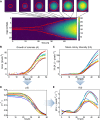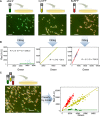Low cost and open source multi-fluorescence imaging system for teaching and research in biology and bioengineering
- PMID: 29140977
- PMCID: PMC5687719
- DOI: 10.1371/journal.pone.0187163
Low cost and open source multi-fluorescence imaging system for teaching and research in biology and bioengineering
Abstract
The advent of easy-to-use open source microcontrollers, off-the-shelf electronics and customizable manufacturing technologies has facilitated the development of inexpensive scientific devices and laboratory equipment. In this study, we describe an imaging system that integrates low-cost and open-source hardware, software and genetic resources. The multi-fluorescence imaging system consists of readily available 470 nm LEDs, a Raspberry Pi camera and a set of filters made with low cost acrylics. This device allows imaging in scales ranging from single colonies to entire plates. We developed a set of genetic components (e.g. promoters, coding sequences, terminators) and vectors following the standard framework of Golden Gate, which allowed the fabrication of genetic constructs in a combinatorial, low cost and robust manner. In order to provide simultaneous imaging of multiple wavelength signals, we screened a series of long stokes shift fluorescent proteins that could be combined with cyan/green fluorescent proteins. We found CyOFP1, mBeRFP and sfGFP to be the most compatible set for 3-channel fluorescent imaging. We developed open source Python code to operate the hardware to run time-lapse experiments with automated control of illumination and camera and a Python module to analyze data and extract meaningful biological information. To demonstrate the potential application of this integral system, we tested its performance on a diverse range of imaging assays often used in disciplines such as microbial ecology, microbiology and synthetic biology. We also assessed its potential use in a high school environment to teach biology, hardware design, optics, and programming. Together, these results demonstrate the successful integration of open source hardware, software, genetic resources and customizable manufacturing to obtain a powerful, low cost and robust system for education, scientific research and bioengineering. All the resources developed here are available under open source licenses.
Conflict of interest statement
Figures






Similar articles
-
Multifunction fluorescence open source in vivo/in vitro imaging system (openIVIS).PLoS One. 2024 Mar 18;19(3):e0299875. doi: 10.1371/journal.pone.0299875. eCollection 2024. PLoS One. 2024. PMID: 38498588 Free PMC article.
-
Exploiting open source 3D printer architecture for laboratory robotics to automate high-throughput time-lapse imaging for analytical microbiology.PLoS One. 2019 Nov 19;14(11):e0224878. doi: 10.1371/journal.pone.0224878. eCollection 2019. PLoS One. 2019. PMID: 31743346 Free PMC article.
-
PiRamid: A compact Raspberry Pi imaging box to automate small-scale time-lapse digital analysis, suitable for laboratory and field use.HardwareX. 2022 Nov 15;12:e00377. doi: 10.1016/j.ohx.2022.e00377. eCollection 2022 Oct. HardwareX. 2022. PMID: 36437840 Free PMC article.
-
Open Hardware for Microfluidics: Exploiting Raspberry Pi Singleboard Computer and Camera Systems for Customisable Laboratory Instrumentation.Biosensors (Basel). 2023 Oct 23;13(10):948. doi: 10.3390/bios13100948. Biosensors (Basel). 2023. PMID: 37887141 Free PMC article. Review.
-
Low-cost and open-source strategies for chemical separations.J Chromatogr A. 2021 Feb 8;1638:461820. doi: 10.1016/j.chroma.2020.461820. Epub 2020 Dec 24. J Chromatogr A. 2021. PMID: 33453654 Free PMC article. Review.
Cited by
-
Low-Cost Microplate Reader with 3D Printed Parts for under 500 USD.Sensors (Basel). 2022 Apr 23;22(9):3242. doi: 10.3390/s22093242. Sensors (Basel). 2022. PMID: 35590932 Free PMC article.
-
ElectroPen: An ultra-low-cost, electricity-free, portable electroporator.PLoS Biol. 2020 Jan 10;18(1):e3000589. doi: 10.1371/journal.pbio.3000589. eCollection 2020 Jan. PLoS Biol. 2020. PMID: 31922526 Free PMC article.
-
Fast Colony Forming Unit Counting in 96-Well Plate Format Applied to the Drosophila Microbiome.J Vis Exp. 2023 Jan 13;(191):10.3791/64298. doi: 10.3791/64298. J Vis Exp. 2023. PMID: 36715413 Free PMC article.
-
Facile assembly of an affordable miniature multicolor fluorescence microscope made of 3D-printed parts enables detection of single cells.PLoS One. 2019 Oct 10;14(10):e0215114. doi: 10.1371/journal.pone.0215114. eCollection 2019. PLoS One. 2019. PMID: 31600202 Free PMC article.
-
Deep learning for Alzheimer's disease: Mapping large-scale histological tau protein for neuroimaging biomarker validation.Neuroimage. 2022 Mar;248:118790. doi: 10.1016/j.neuroimage.2021.118790. Epub 2021 Dec 20. Neuroimage. 2022. PMID: 34933123 Free PMC article.
References
-
- Gibney E.'Open-hardware' pioneers push for low-cost lab kit. Nature. 2016;531(7593):147–8. doi: 10.1038/531147a - DOI - PubMed
-
- Baden T, Chagas AM, Gage G, Marzullo T, Prieto-Godino LL, Euler T. Open Labware: 3-D Printing Your Own Lab Equipment. PLOS Biol. 2015;13(3):e1002086 doi: 10.1371/journal.pbio.1002086 - DOI - PMC - PubMed
-
- Pearce JM. Building Research Equipment with Free, Open-Source Hardware. Science. 2012;337(6100):1303–1304. doi: 10.1126/science.1228183 - DOI - PubMed
-
- Pearce J. M. Laboratory equipment: Cut costs with open-source hardware. Nature. 2014; 505 (7485), 618. - PubMed
MeSH terms
Grants and funding
LinkOut - more resources
Full Text Sources
Other Literature Sources
Research Materials
Miscellaneous

